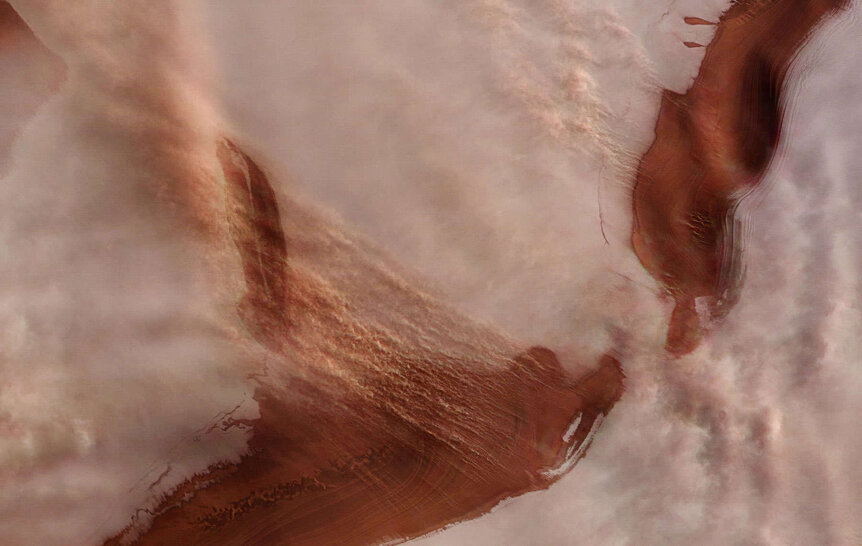Create a free profile to get unlimited access to exclusive videos, sweepstakes, and more!
How about a scoop of cinnamon caramel Martian polar ice cream?

No matter how many gorgeous photos of Mars I see from visiting spacecraft, I still have this perception of the landscape of Mars as being hard, dry, sharp-edged; like a red-hued chunk of volcanic rock that you have to handle carefully lest you get cut.
But perhaps this prejudice has been reinforced by close-up images of the barren, rough-hewn surface taken by landers and rovers.
When you take the longer view — say, from orbit — then Mars transforms. It's no longer a field of gritty ochre gravel. It's… a refreshingly cool bowl of cinnamon gelato.
Oh, yeah. Scoop me up some of that. But have a care! That dessert spoon will really stick to your lips.
This is a swath of the north polar region of Mars seen by the European Space Agency's Mars Express orbiter. It was taken in the Martian northern summer, of all things, in 2006. The polar cap of Mars has a permanent covering of thick water ice, coated with frozen carbon dioxide (dry ice) in the winter. In the spring and summer that coat turns to gas, adding to the atmosphere of the planet.
The white part is water ice, well below its freezing point, but the swaths of cinnamon-red are troughs, exposed surface, part of a much larger overall spiral pattern away from the pole. The pattern may be from winds blowing away from the pole, twisted around as the planet rotates. You can also see layering in the troughs, generations of sediment deposited eons ago.
The overall image is a little over 300 kilometers long, and the Martian north pole very roughly 300 km away to the upper right.
I imagine the view of this area from the ground is quite lovely, if almost instantly deadly without a pressure suit. The Martian atmosphere is less than 1% the pressure of Earth's at sea level, and of course it's not exactly tropical there.
Which only emphasizes just how lovely this is from several hundred kilometers up.
Local storms create winds that can pick up material from the exposed parts, creating dream-like vistas of streamers and billowing red dust clouds. The air is so thin that even a hurricane-speed wind on Mars would feel like a breeze, the reduced density lowering the force of the wind. The dust would still hit you at high speed, though, remaining dangerous… but then again that shows how much lovelier it is to see Mars from a height.
I'd wager that someday, perhaps in the next decade or two, humans will have this view in person or one much like it. And eventually some will venture down to the surface, watched from above by comrades stationed aboard an orbiter to stay on top of changing weather conditions as well as continue science operations that can only be done from high above.
To be honest, I'm not sure who I'm envious of more.
But they'll both play their roles, and our knowledge of this Earth-that-isn't will increase vastly, as will, no doubt, our appreciation of its chilling beauty.






























